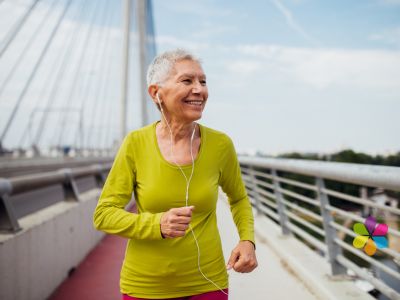The falls of people over 65 can be highly traumatic. Around 41,000 people each year suffer from falls that require hospital. In 2021, there were 1200 deaths that resulted from falls.
But the good news is they’re often preventable.
This month, we’re focusing on April Falls Prevention. The statistics say that one in three Australians 65 or better will have a fall every year. These often result in hip fractures.
Reports indicate the annual cost of hip fractures to Australia is in the league of $1 billion.
In addition to direct healthcare costs, which are eye-watering, there is reduced quality of life and lost productivity.
The Clinical Excellence Commission has released a report, which highlights the cost and trauma of falls. It also gives examples of local solutions.
There are plenty of ideas and resources available from NSW Government, including a healthy journey tool kit and free personal health coaching. This way, we can keep our treasured older people (or us if we’re in that group) upright.
Elara’s favourite flower has always been the soft pink and white of her camellia sesanqua. It flowers in March and April every year and puts on a glorious show. One day, after hurrying to the letterbox, Elara slipped on the petal-strewn path. She landed in hospital with a broken hip.
Falls Prevention Strategies
- Staying Active
Staying active and on your feet is good for your body and mind. These are some of the flow-on benefits of being active.
- Better muscle strength and balance — regular exercise increases strength in your legs and core, which helps you remain stable on uneven surfaces or with unexpected obstacles
- More coordination and flexibility — activities like tai chi and yoga are perfect for improving balance, coordination and flexibility
- Lower risk of physical decline — regular activity will improve bone muscle density
- Greater confidence and mobility — safe movement aids your ongoing independence
2. Identify any hazards
Check around your home for hazards to rectify:
- Loose rugs and mats
- Good lighting
- Non-slip footwear
- Grab bars and railings
- Slippery floors (or a carpet of flower petals on the footpath)
- Showers and baths that might need a chair
3. Healthy eating
Make your regular diet full of real food, not convenience food.
Seasonal vegetables, fruit, whole grains like rice, pasta, quinoa, beans, and legumes are delicious, affordable, and satisfying. These complex carbohydrates will give you the fuel you need for your day.
Healthy sources of protein include nuts, lean cuts of meat, tofu, tempeh, beans, chia seeds, and sunflower seeds.
Calcium-rich foods like green leafy vegetables, oranges, almonds and walnuts, figs, fatty fish, tofu, and yoghurt.
Hydration is crucial, especially when exercising. Drink plenty of water and eat water-rich food like bok choy, celery, cucumbers, watermelon, tomatoes, oranges, strawberries, and others.
Vitamin D is important for bone health, muscle function, and your immune system. We can get Vitamin D from sunshine, foods, and supplements. Our skin creates vitamin D when it gets exposure to ultraviolet sunshine. Two eggs will give you about 82 percent of your daily recommended intake.
A vitamin D3 tablet can help raise your levels if you’re low in vitamin D. Speak to your doctor about testing.
In summary, preventing falls is about keeping physically active, fixing or removing any hazards, and eating well to maintain or strengthen your body. You never know, you just might have a lot of fun, make new friendships, and feel better than ever.
April Falls Prevention month
This April 2025 is Falls prevention Month. Let’s all do our best to get strong, stay active, have fun, and keep upright. Preventing falls is everyone’s business.
An internationally-recognised falls prevention program is Stepping On. It runs for two hours a week for seven weeks and is targeted at people who live at home, have had a fall, or are fearful of having a fall. Stepping On contains a comprehensive series of helpful topics including hazard prevention, medication, vision, vitamin D, exercise, balance, and safe movement.
Stepping On is part of NSW Health’s ‘Active and Healthy’ Program. Find a local program here.
Tips for starting an exercise program
- Start slow
- Be realistic in your goals
- Choose what you enjoy (whether alone or in a group)
- Choose activities you enjoy (eg dancing, aerobics, aqua classes)
- Identify any barriers holding you back eg travel, transport, walking distances. Consider how you can get around these barriers. For example, you might be able to get a lift or carpool. If you feel self-conscious, it’s likely everyone does. Don’t let that stop you.
- Be inspired by others
Resources and links
The Clinical Excellence Commission has information booklets on how useful topics for fall prevention. They include dizziness, eyesight, how to get up if you have a fall, medications, foot care and safe footwear.
Exercise Programs as part of NSW Govenment Falls Prevention month
Healthy Eating and Active Living has many over 50s programs.

After Elara was discharged from hospital, tests revealed she had low bone density, so a higher calcium diet, more vitamin D3 from eggs and a supplement, and some strength training was advised. She discarded her threadbare slippers for a sturdier kind with a non-slip sole.
At home, Elara moved her beloved camellia into a large ornate pot a few metres from her path.
Elara also got herself a free physical health coach and began a delightful adventure in tai-chi, weight lifting, and yoga. After a slow start, her life has changed. Elara now feels fit and strong. What’s on the horizon? Boxing.
This is general information that doesn’t consider your personal health situation or needs. For advice that’s right for you, nothing beats a consultation with a good doctor.
